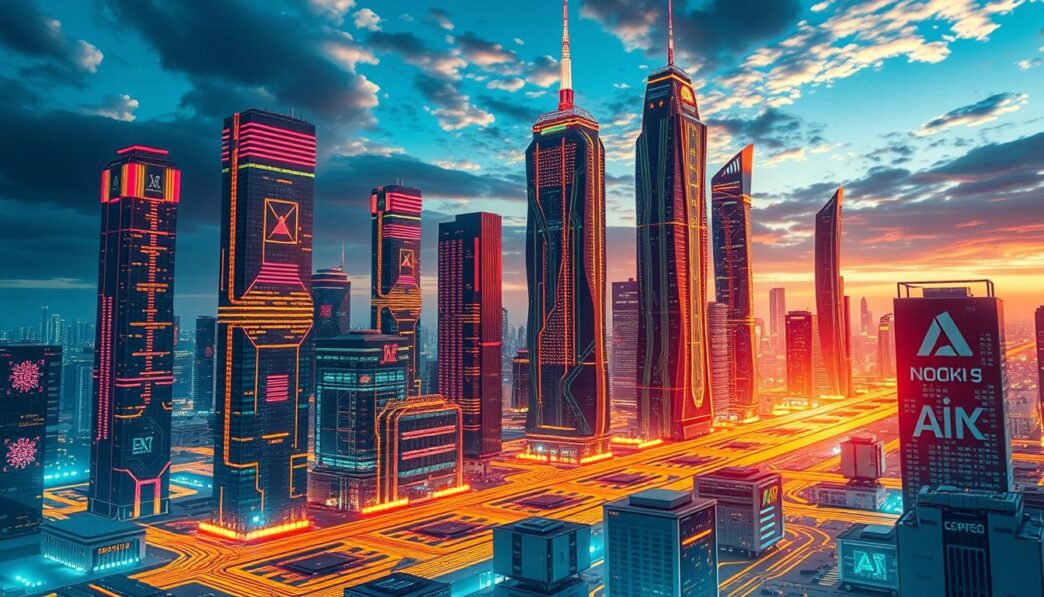Gordon Moore made a bold prediction in the 1960s. It’s still guiding us today. As we near 2024, Moore’s Law is key to improving semiconductors. Intel’s work keeps pushing what’s possible in computing.
Since the 1960s, computing power has grown a lot. Now, microchips have up to 50 billion transistors. This shows how far technology has come.
But, we’re getting close to the limits of what’s possible. We’re talking about the end of Moore’s Law. Intel’s 7nm chip is a big step forward. It uses new technology to get us closer to the 2nm mark.
This miniaturization has made computing much more powerful. It’s also led to big improvements in many areas.
Key Takeaways
- Gordon Moore’s vision laid the groundwork for a computing future defined by rapid, consistent semiconductor advancements.
- Intel breakthroughs have remained crucial in pushing forward transistor miniaturization, sustaining Moore’s Law’s trajectory.
- The semiconductor industry’s evolution from micrometer to nanometer transistor sizes has fueled global economic and technological progression.
- Modern challenges in decreasing transistor space signal a potential pivot point for Moore’s Law and the future of computing.
- Innovative architectures and materials are key to overcoming the physical limitations of current semiconductor technologies.
- Quantum and neuromorphic computing are emergent fields that may redefine the principles underpinning Moore’s Law.
A Brief Recap: Moore’s Law Explained
Gordon Moore, co-founder of Intel, had a huge impact on our world. His Moore’s Law started in 1965. It has led to huge growth in microchips, changing computing forever.
Origins and Historical Significance of Moore’s Law
In 1965, Gordon Moore wrote an article that changed everything. He noticed transistors on chips doubled every year since they started. He said this would keep happening for a long time.
This idea, known as Moore’s Law, was first shared in 1964. Moore’s work with ECS, where he became an honorary member, shows his big impact.
Here’s a quick look at Moore’s key moments:
- Joined ECS in 1957, a key part of his career
- Gave a landmark talk in 1964 that started Moore’s Law
- Passed away in 2023, leaving a lasting legacy in tech
Theoretical Underpinnings and Technological Predictions
Moore’s Law is about doubling transistors on microchip evolution. This has driven the industry to keep up with Moore’s predictions. We’ve seen chips go from thousands to billions of transistors, showing amazing progress.
Moore’s vision changed how we develop technology. It focused on making tech better and cheaper.
The effects of Moore’s Law are huge. They mean computers get faster, cheaper, and use less power. This has made our world more connected.
Moore’s Law still guides us today. It helps us see what’s possible and what’s not. Even though it’s facing challenges, it keeps pushing us to innovate.
To learn more about Moore’s Law and its future, check out Is Moore’s Law coming to an end or still going strong? It explores how this key idea might evolve.
The Legacy Impact of Moore’s Law on Technology
Since 1965, Moore’s Law has led to huge leaps in computing advancements. It’s not just about microprocessor efficiency. It drives growth in many industries.
Revolutionizing Computing, Electronics, and Various Industries
Moore’s Law affects more than just computers. It changes healthcare, finance, and communication. With smaller transistors, devices get smarter and use less energy.
This change helps industries use AI and IoT in their daily work. It brings many high-tech society benefits.
The Evolution of Microchip Efficiency and Performance
The push for better microprocessors has led to amazing changes. Smartphones now do what used to need supercomputers. This is thanks to the growth in microprocessor efficiency.
New materials like graphene are pushing these advancements even further. They keep Moore’s Law alive.

Thanks to Moore’s Law, technology is everywhere. From watches to data centers, it’s affordable and powerful. This makes technology more accessible, driving more growth and innovation.
As we look into new technologies like quantum computing, Moore’s Law guides us. It ensures technology keeps changing and improving our lives.
Milestones in Semiconductor Advancements
The journey of semiconductor technology is filled with semiconductor milestones and Intel chip advancements. It started with integrated circuits and now we’re in the era of nanometer technology. Each step shows our dedication to innovation.
From 65,000 Components to 50 Billion Transistors
The growth of transistor counts in microchips shows the power of Moore’s Law. It started with doubling transistor density every year, then every two years. This rule has pushed the limits of microchip technology.
Now, we have billions of transistors in microchips. This shows how far we’ve come in making chips smaller and more efficient.
Intel’s Innovation Triumphs in Nanometer Technology
Intel has led the way in nanometer technology. They’ve moved from 22nm to 2nm transistors. Their work has made computers faster and more energy-efficient.
They’ve also worked with ASML to use high-NA EUV lithography systems. This is a big step towards the 1nm node.
| Year | Technological Advancement | Impact on Semiconductor Industry |
|---|---|---|
| 2012 | Introduction of 22nm Technology | Paved the way for more powerful, yet energy-efficient chips. |
| 2022 | Development of 2nm Transistor Technology | Enabled unprecedented increases in computing performance and circuit efficiency. |
| Expected 2030 | Advancement to 1nm Node | Promises a breakthrough in ultra-compact, high-performance processors. |
The journey of semiconductor milestones keeps pushing the limits of technology. It’s not just small steps, but big leaps in capacity and efficiency. As we move forward, these advancements will change computing and the semiconductor market.
Moore’s Law in the Lens of Modern Computing Challenges
Moore’s Law has guided the rapid growth in computing for years. But, we face big computing limitations due to physical and material science barriers. These challenges mark a turning point for innovative technology in computing.
The shift from micro to nano in semiconductors is a huge leap. Yet, as transistors get smaller, keeping up with Moore’s Law gets harder. Quantum mechanics causes problems like heat and electron leakage, making miniaturization tough.
| Technology | Transistor Count | Year |
|---|---|---|
| Intel’s First Microprocessor (1971) | 2,300 | 1971 |
| NVIDIA Blackwell Architecture | 208 Billion | 2022 |
| Cerebras WSE-3 | 4 Trillion | 2023 |
New areas in material science offer hope. For example, silicon-germanium alloys might solve silicon’s problems. Quantum and neuromorphic processors also change how we do computing, thanks to innovative technology.
Quantum computers use qubits for superposition, offering huge power boosts. Unlike regular processors, quantum ones can do many things at once, making them much faster.
Neuromorphic computing tries to mimic the brain. It uses spiking neural networks to process data quickly and efficiently. This helps solve problems of heat and slow speeds.

Advances in material science and innovative technology keep pushing microchip limits, despite computing limitations. The mix of old and new tech, like photonics and 3D transistors, might shape computing’s future. This could keep Moore’s Law alive in a new way.
Is Moore’s Law Drawing to a Close?
As we explore the world of smaller and more powerful computers, Moore’s Law limitations, miniaturization barriers, and economic challenges are key topics. These factors are crucial in understanding Moore’s Law’s future. This law has guided the doubling of transistors on chips every two years.
The limits of materials and the cost of scaling suggest we might soon reach the end of this trend. Can Moore’s Law still lead the way in computer advancements?
The Physical and Economical Barriers to Further Miniaturization
Trying to make transistors smaller hits big walls as they near atomic sizes. Studies show that transistors can only shrink so far. Silicon technology, the backbone of Moore’s Law, faces quantum limits.
Professor Kale of UIUC says we might see up to 100 billion transistors per chip by 2025. Yet, new tech like nanosheet FETs and 3D chiplet architecture offer hope for Moore’s Law’s future.
Gordon Moore’s Reflections on the Limits of Materials
Gordon Moore, the law’s creator, has also worried about material limits. He believes the atomic scale is a real barrier to shrinking transistors further. This highlights a natural end to this technological journey.
| Year | Transistor Count |
|---|---|
| 1968 | 020 μm |
| 1971 | 010 μm |
| 1984 | 001 μm |
| 2005 | 065 nm |
| 2020 | 005 nm |
| 2025 (Estimated) | 002 nm |
The future of computing depends on more than just shrinking transistors. New tech like software-defined architectures and AI are key. The economic challenges of these innovations will decide Moore’s Law’s future.
Looking ahead, understanding these challenges is vital. It helps us prepare for a future where traditional scaling may not apply.
Moore’s Law 2024 and Beyond: Sustainable Growth or a Dead End?
As we move into 2024, the future of Moore’s Law is filled with both hope and doubt. This key idea in computing has set the pace for technological growth for decades. But, as we hit atomic limits and face economic challenges, its future is uncertain.
The drive to make microchip scaling better has been crucial for semiconductors. It has pushed industries forward and changed what’s possible in tech. Yet, the question of whether we can keep up this pace is growing. The debate on whether Moore’s Law should still lead future semiconductor development is critical for technological growth.
| Indicator | Current Status | Future Projection |
|---|---|---|
| SMH Index Growth | 25% increase this year | Continued growth expected |
| Semiconductor Industry Valuation | US$1 trillion within 5 years | Expanding market potential |
| Nvidia ROA & ROE | Significant expansion | Predicted to influence share price positively |
Companies are now using new technologies like GaN to cut energy use. This is important because the tech industry has a big environmental impact. Also, big names like Google and Amazon are making their own chips. This could change the semiconductor world a lot.
The cost of making advanced chips is also a big issue. Making chips like the 7 nm can cost over $300 million. For 5 nm chips, the cost is even higher. This makes it hard to keep up with Moore’s Law.
- Continued evaluation of Moore’s Law’s relevance
- Adaption to new economic and environmental realities
- Integration of emerging technologies to sustain growth
The talks about the future of Moore’s Law are very important now. For half a century, it has been a reliable guide. But, the semiconductor industry might need new ways to grow and stay sustainable.
Cutting-Edge Developments Reshaping Moore’s Law
The world of semiconductors is changing fast. New technologies like new semiconductor materials, 3D chip stacking, quantum computing, and neuromorphic chips are pushing the limits of Moore’s Law. These innovations promise to boost computing power beyond what we have today.
Alternatives to Silicon and the Potential of New Materials
The chip industry is moving away from silicon. It’s now looking at materials like graphene and transition metal dichalcogenides. These materials could make chips faster and more efficient. This change could greatly impact industries that rely on fast computing.
Innovations in 3D Chip Stacking and Transistor Design
3D chip stacking is changing how chips are made. By stacking chips, we can fit more transistors in a smaller space. This makes chips work better, use less power, and produce less heat.
The Role of Quantum and Neuromorphic Computing
Quantum computing and neuromorphic computing are changing how we process information. Quantum computers can do calculations much faster than regular computers. Neuromorphic chips work like the brain, making them great for complex tasks and learning.
These new technologies are not just making computing better. They’re also key to creating artificial intelligence that can think and act like humans. To learn more, check out the social impact of generative AI.
Moore’s Law is evolving, not ending. New materials, 3D chip stacking, and quantum/neuromorphic computing are just the start. They show that computing is still growing and adapting to our needs.
The Effects of Moore’s Law on Global Economics and Trade
The semiconductor industry is key to today’s global economy, thanks to Moore’s Law. This rule says the number of transistors on a chip doubles every two years. It has led to huge growth in the industry, changing global trade a lot.
Now, semiconductors are the third-most traded item worldwide by value. Their rise shows in both volume and value. They’ve become crucial in our digital world, making tech cheaper and more accessible. This has made technology available to more people, making it more democratic.
The plummeting cost of transistors, a direct descendant of Moore’s law, has significantly democratized technology access worldwide, reshaping economic landscapes and trade policies.
But, Moore’s Law is hitting physical limits, and the industry is at a turning point. It’s expected to hit $1 trillion in revenue by 2030. Companies like Taiwan’s TSMC are pushing the limits with new technologies, like the two-nanometer process.
- Technological Influence: Advances in AI and other tech rely heavily on better semiconductors.
- Economic Impact: Sectors like autos and telecoms depend on semiconductors, affecting trade and policies.
- Innovation Drive: New ideas like photonic and neuromorphic chips keep the industry vibrant.
Future innovations, like compute in memory and neuromorphic chips, promise to keep the industry’s impact strong. Even as it moves beyond old scaling laws, its role in global economics and trade will grow.
In summary, Moore’s Law and semiconductor progress have a big impact on global economics and trade. As these technologies evolve, their influence grows, changing markets and policies worldwide. The semiconductor industry is a key player in international trade, shaping our future tech and economy.
Future Pathways for Computing: Beyond Moore’s Law
As we move past Moore’s Law, computing is evolving fast. This brings exciting changes in how we use technology. Optoelectronics advances and photonics are leading the way in data processing and communication.
Expanding Horizons with Optoelectronics and Photonics
Optoelectronics and photonics use light to make tech faster and more efficient. They help send data quickly over long distances. This tech is used in fast internet and biosensing.
With photonics and electronics working together, we can handle more data and use less energy. This is a big step forward.
New materials like graphene are making photonic circuits better. This shows how changing materials can change electronics a lot.
Distributed Computing and AI-Driven Efficiency Gains
Distributed computing is making computing better by using many computers together. This way, tasks are done faster and more efficiently. It also helps avoid data jams.
Adding AI optimization makes distributed computing even better. AI helps manage tasks in the network. This makes the system more reliable and ready for more data.
These technologies—optoelectronics advances, photonics, distributed computing, and AI optimization—are key to going beyond Moore’s Law. They help computing move forward, limited only by our creativity and innovation.
Conclusion
The world of semiconductors has shown great strength, growing beyond what Gordon E. Moore predicted in 1965. We’ve explored how Moore’s Law has shaped the industry, even as its pace has slowed. Today, in 2024, Moore’s Law still drives big advances, like the rise of new transistor types and more funding for semiconductors.
Today, chips hold 50 billion transistors, the size of a fingernail. This shows Moore’s vision and the industry’s drive for progress. With $146 billion in investment, the push for better computing power is clear. Leaders like Philip Wong and Pat Gelsinger show Moore’s Law’s impact goes beyond just transistors, fueling innovation in our tech world.
The future of computing might change how we measure progress in semiconductors. Even as Nvidia’s Jensen Huang sees the end of Moore’s Law’s era, its spirit guides the industry. The semiconductor world is ready to open new technological doors, changing society for the better for years to come.


















